Here’s a bit of trivia you may not know…this year (2018) marks the 127th anniversary of the American Tuxedo. How’s that for a segway for us to pay tribute to the always dapper and impeccably dressed tuxedo cat! [The article that follows is an updated re-post of one we did back in late 2016.]
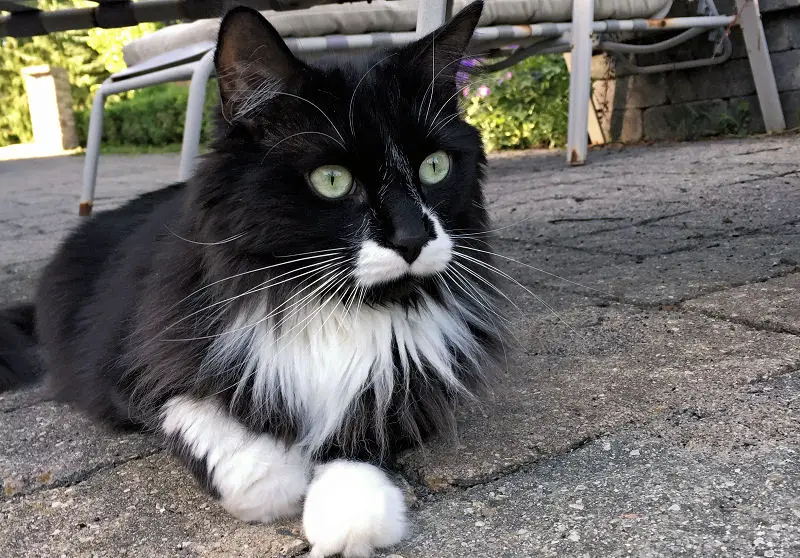
Photo: our tuxie (Newman)
Back in October of 1886 New York’s social elite gathered at a brand new exclusive country club called Tuxedo Park for their first annual Autumn Ball. Attendees included many well known upper class gentlemen such as William Waldorf Astor and JP Morgan. As was custom they dressed in their black tailcoats, starched white shirts and formal bow ties.
But there was also a small group of young mavericks who decided to have a bit of fun with the era’s obligatory evening attire and arrived in a variation so outlandish it was reported in all the local newspapers. Each of these fashion renegades wore a tail-less dress coat and waistcoat of scarlet satin. How shocking! This apparently marked the debut of the shorter version of the formal coat which would eventually take the name of the club where it first appeared. And voila, the Tuxedo was born.
Formal fashion conscious cats have known the secret allure of the tux long before these socialites and their country clubs. Indeed, tuxedo cats look like they’re always ready to go the opera or a special gala. Just ask our tuxie (Newman).
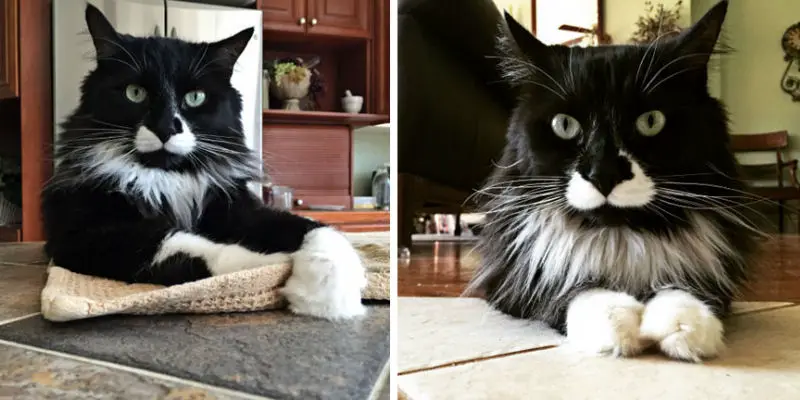
Photo: our tuxie (Newman)
Tuxies are very striking in their appearance and we lovingly refer to them as “nature’s version of elegance and sophistication.” Most are known to have real ‘tuxitude’ and know how sharp they look. Our tuxie is always up for a photo op and dons his regal air whenever the camera approaches.
Definition
OK, so what exactly is a tuxedo cat? Is it a cat breed? Is it just a color pattern?
The answer to the second question is no, tuxedo cats are not a cat breed. They just happen to have a very unique coat pattern and coloring. In fact, tuxedo cats are bi-color cats. They are true black and white feline beauties. This answers the third question.
Now, the answer to the first question (what is a tuxedo cat?) … for a cat to be a tuxedo cat, she must be bi-color and have the following characteristics:
- She must have solid black throughout her entire body (except for a few white patches).
- The white patches must be on her chin, chest, belly, and paws.
- She must have more black than white.
Tuxedo cats look as if they’re wearing a tuxedo. No question with these two beauties!
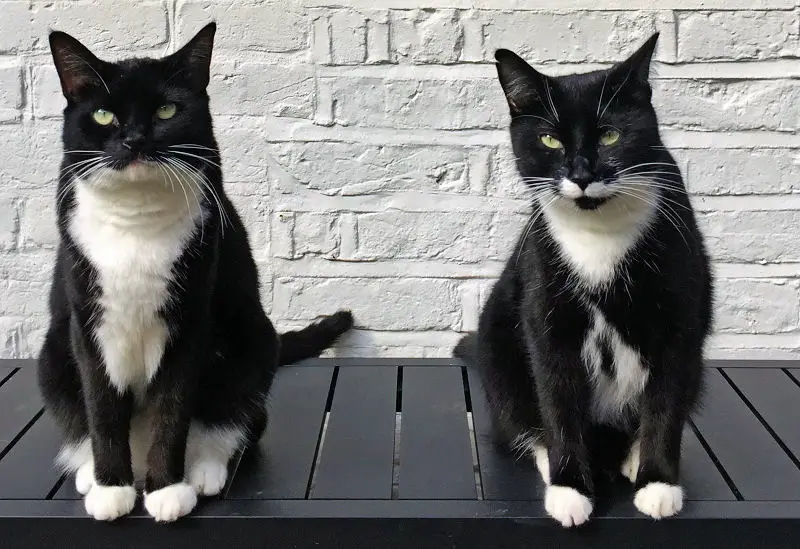
Photo credit: © Marjan Debevere
It is important to note that not all black and white cats are tuxedos. There are some bi-color, black and white cats that are not tuxedos. Some of these cats, for example, may have more white than black, or be half black and half white, or have solid white throughout their bodies and just have a few small patches of black. These kitties are not considered tuxedos.
The genes of white spotting are more dominant and easily masks the true color of the cat where white color occurs. Tuxedo cat have inherited the genes for solid color and a gene for white color spots.
[clickToTweet tweet=”A Tribute to Tuxedo Cats on the 127th anniversary of the American Tuxedo” quote=”A Tribute to Tuxedo Cats on the 127th anniversary of the American Tuxedo”]
Bi-color Patterns
Other black-and-white bi-color coat patterns include the “masked cat” pattern (also known as “mask-and-mantle” pattern). These cats seem to be wearing a black mask over a white face and/or a black mantle on their backs.
Another pattern is the “cow cat” and like the name suggests, they look like cows. These cats don’t have one big patch of solid black. Instead, they show small patches of black over white fur. Just like one of our favorite cats – Scotch {the cow cat}.
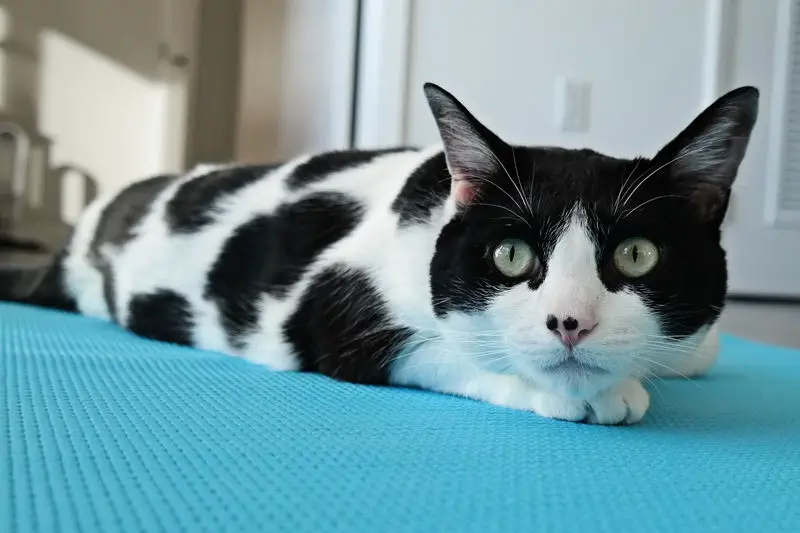
Photo credit: @scotch_thecowcat
Here are the most common pattern variations:
- Cow pattern. A predominantly white cat with black spots or patches on the torso.
- Van pattern. A white cat with black markings on the head and tail only.
- Mask-and-mantle pattern. A cat with a black back, shoulders, and head, and a white underside.
- Cap and saddle pattern. A cat with black over the top of the head, white shoulders, and a large black patch on the lower back, near the tail.
- Locket pattern. A black cat with one small white patch on the chest or tummy.
See the bi-color pattern chart below for the different coat types.
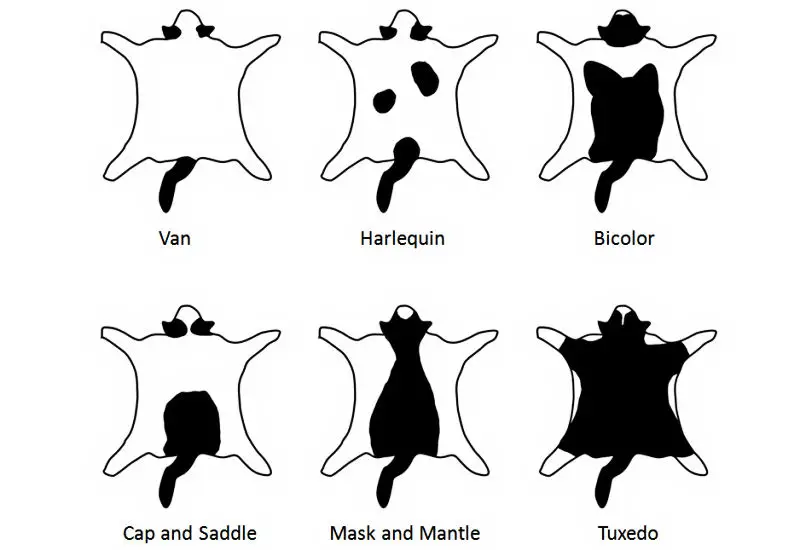
Photo: Flickr Commons
Some black and white cats show patterns with swirls and stripes and some even look like skunks. The amount of black and white may vary. For instance, some cats may have a mostly white coat with black swirls and stripes while others may show equal amounts of black and white. These patterns, however, are not considered to be tuxedos.
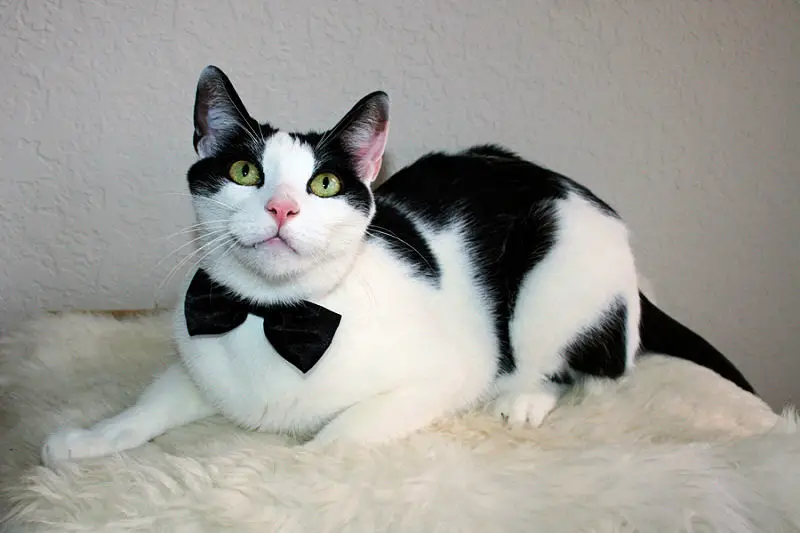
We noted above that tuxedos are not a breed, but they may occur in different cat breeds. The tuxedo pattern occurs equally in both long hair and short hair cats. Indeed, bi-color coats (including the tuxedo pattern) occur in several breeds, including the American Shorthair, British Shorthair and Persian.
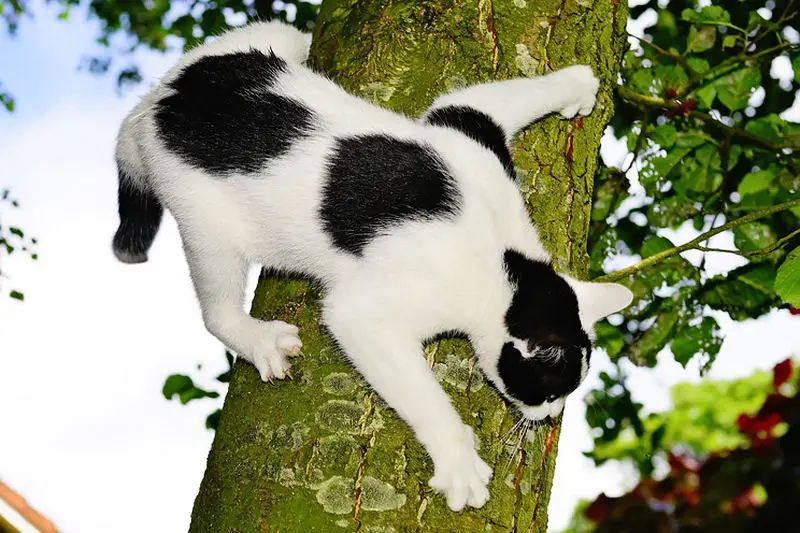
The first longhaired tuxedo cat seen in Western Europe were of Persian breed and they arrived some time in the 19th century. Back then, they enjoyed a great popularity. Persian tuxedos have longer, thicker fur, fluffy undercoat, immense tails, and round faces. By the end of 19th century, they were among the most wanted pets, attracting the attention of many cat lovers worldwide. However, their fame come to fade in the 20th century due to new longhairs became common favorites.
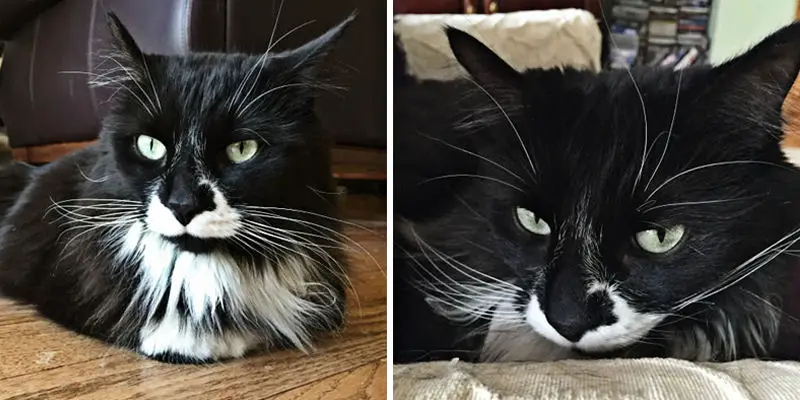
Photo: our tuxie (Newman)
Purr-sonality
Tuxedo cats are very friendly in nature, highly intelligent and also extremely active. They like to communicate with loud vocalizations. They are more vocal as compared to the Persian breeds but less so than Siamese. They are smart and affectionate and very likely to sit on your lap and enjoy your company. They get along well with other pets in the house due to their friendly nature. They may even follow you around the house like dogs. Ours does. 🙂
Some studies suggest that tuxies can be up to 200% smarter than normal domestic cats. Some of the most popular and well-known personalities who have owned tuxedos include William Shakespeare, and Beethoven. Be sure to check out our other tuxie related post: 9 Reasons Tuxedo Cats Rock
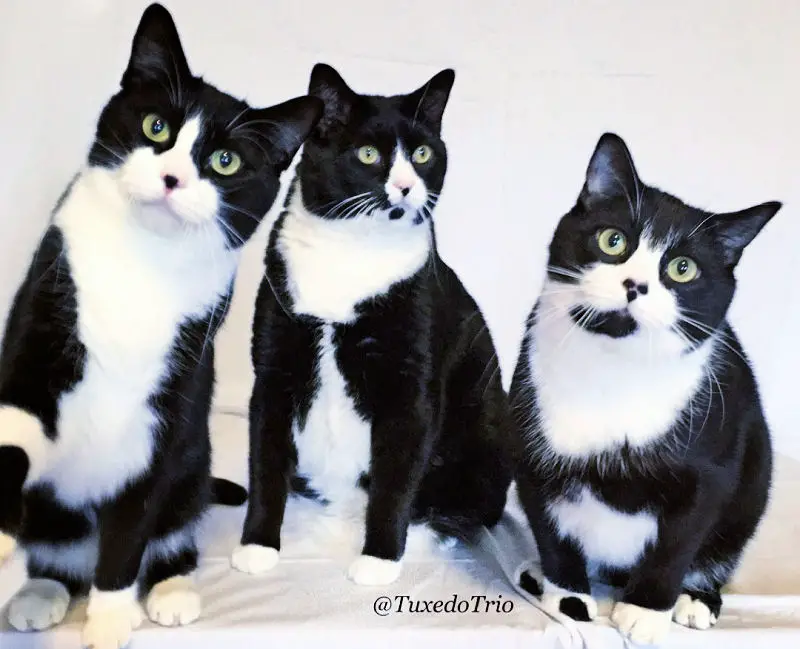 Photo courtesy of @tuxedotrio
Photo courtesy of @tuxedotrio
Famous Tuxies
Now that we have established what makes a tuxedo cat, let’s celebrate some well-known tuxedo cats.
 Tuxedos were immortalized in Old Possum’s Book of Practical Cats, a poem by T.S. Eliot in which a tribe of black and white cats are the protagonists. In the book, the tuxedo kitties were known as “Jellicle Cats”.
Tuxedos were immortalized in Old Possum’s Book of Practical Cats, a poem by T.S. Eliot in which a tribe of black and white cats are the protagonists. In the book, the tuxedo kitties were known as “Jellicle Cats”.
 Other famous tuxedos include Sylvester the Cat (of Looney Toons fame), Felix the Cat (who became a star of the silent era), Tom (of Tom and Jerry), Mr. Mistoffelees of Cats! the musical by Andrew Lloyd Webber and even Dr. Seuss’s “Cat in the Hat” is a tuxedo. TV trivia: anyone recognize the cat below (right)?
Other famous tuxedos include Sylvester the Cat (of Looney Toons fame), Felix the Cat (who became a star of the silent era), Tom (of Tom and Jerry), Mr. Mistoffelees of Cats! the musical by Andrew Lloyd Webber and even Dr. Seuss’s “Cat in the Hat” is a tuxedo. TV trivia: anyone recognize the cat below (right)?
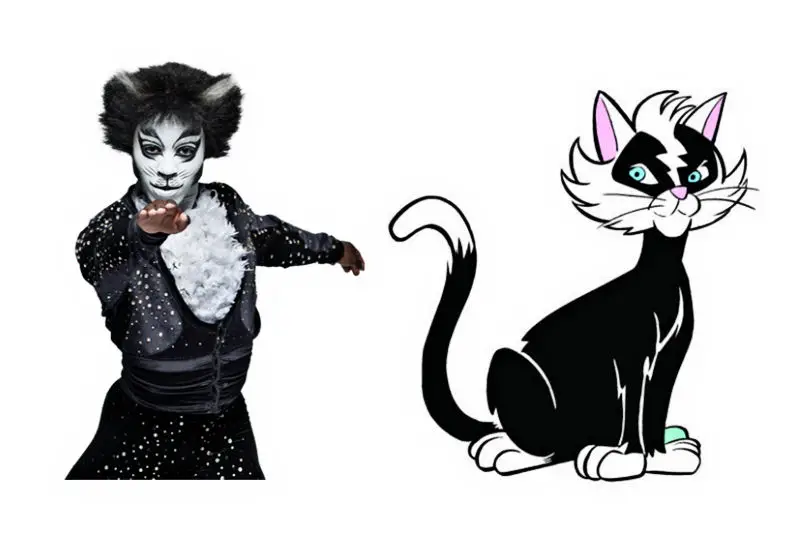 Cartoon photos: Flickr Commons
Cartoon photos: Flickr Commons
Let’s not forget Socks – former President Clinton’s cat who called the White House home, and Humphrey the “Chief Mouser” at 10 Downing Street, the official residence of the U.K. Prime Minister, for 18 years.
A Purrington Post Feature Spotlight
And now for a special treat…let’s meet two of Newman’s favorite IG tuxie families…the Fab Four from London and the Boston Beauties!
Introducing London’s Fab Four!
OK, only 2 of the Fab 4 are true tuxies by the definition we used earlier but they’re all equally adorable to us. Super cat-mom Marjan Debevere, is an amateur photographer who lives in London, England. When not taking breathtaking photos of her own clowder, she photographs the cats at Wood Green, a nearby re-homing centre for shelter cats. In her spare time, Marjan studies Feline Behaviour and Psychology. How cat-centric is that! =^..^=
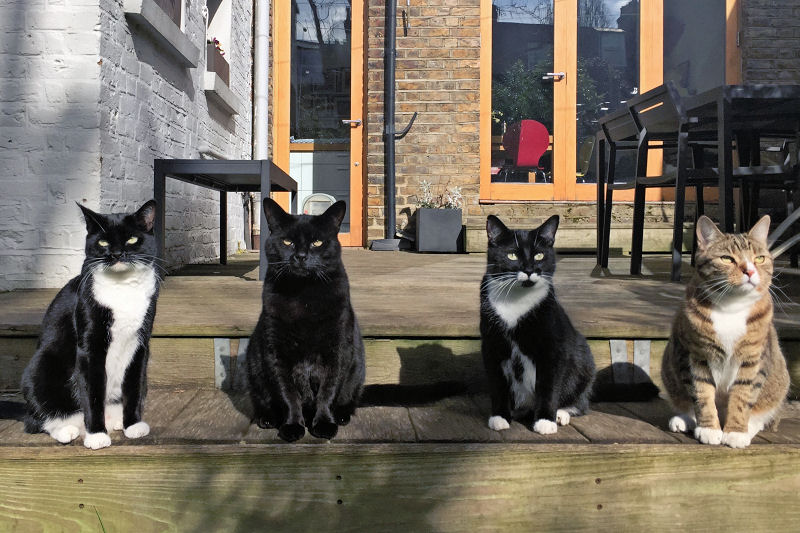
Photo credit: © Marjan Debevere Check out her IG @lillmanlulu_luigi_and_co
Reference above photo…from left, first up is Miss Hula (Poppet), a five-year-old Tuxedo cat who runs the show. Next is Clive, a five-year-old black house panther who was adopted at the same time as Hula. They are unrelated but very bonded. Hula was born at a rescue centre called The Mayhew Animal Home in London and Clive was found in a black dustbin bag left to die at five weeks old. They were put together in a cabin and became inseparable buddies.
Third in line is Luigi (Lill’Man – Lulu – WeegieWoo), 3 years of age (will be 4 in December). He’s the rebel, life & soul of their clowder. And last, but not least, is 2 year old Archie, the sweetest Tabby Tux. He rounds out the Fab Four purrfectly!
Marjan expains…
Through Hula & Clive, I became a volunteer photographer and socialiser at the shelter they came from. On my very first day there I met Luigi. We were doing some press shots of some t-shirts when one of the press officers said, ‘we need a kitten in this shot’. Out came Luigi. He literally took my breath away. I became rather overwhelmed and knew I was in trouble. I drove home that day in floods of tears, overcome by emotion. All my friends and family thought this was quite funny…first day “on the job” and she’s already bringing home a cat…I can’t quite explain what happened that day but I’ve never felt like that since about any of the 2000+ cats I have since photographed in shelters. He is what I refer to as “The forth chamber of my heart.”
[clickToTweet tweet=”A Tribute to Tuxedo Cats” quote=”A Tribute to Tuxedo Cats”]
We asked about Archie’s arrival…
One night, my husband and I woke up in the middle of the night with him sprawled out on his back between us. Archie had decided that he wasn’t going home again. We did try to convince him to go back home, but in the end it was decided by the previous owners that he would be much happier with us, so we officially adopted him about 11 months ago.
Here’s an example of her amazing photography with Hula and Luigi hamming it up for the camera.
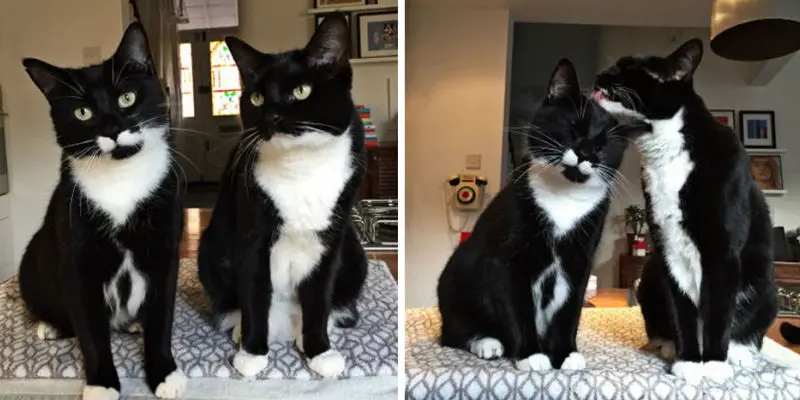
Photo credit: © Marjan Debevere Check out her IG @lillmanlulu_luigi_and_co
When asked if there might be any more additions, Marjan was quick to state; “I have a self-imposed rule when it comes to adopting cats – four and no more!”
Q: How do they all get along?
I am amazed and very lucky to have 4 cats that are totally unrelated but so bonded to each other. The dynamic between the 4 of them is great.
They love to play and play-fight together and are very good about waiting their turn when I play with a stick toy with them. They also have turned allogrooming (mutual grooming) into an Olympic sport and will habitually “share the love of licking in those hard to reach places” at dinnertime, whilst I’m preparing their food.
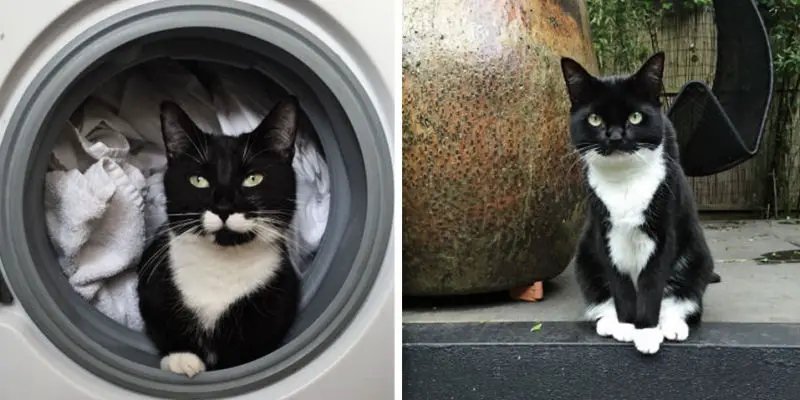
Photo credit: © Marjan Debevere Check out her IG @lillmanlulu_luigi_and_co
Q: Are these the first tuxie’s you’ve owned?
I’ve had tuxies all my adult life. I adopted my first one, Tom, as an “extra” that came with a tabby I adopted some 24 years ago. It really didn’t take me long to get hooked on the “tuxitude”.
Although it is very unlikely that scientists will ever be able to definitively link certain personality traits to particular genes, I would love it if Tuxies could become their own certified breed. Some coat colours have been scientifically linked to certain temperaments so I’m hoping it’s just a matter of time 🙂
The ones I’ve had the pleasure of sharing my life with, Tom (13), Squeek (14), Tash (16), RIP, you were all legends, and now Hula & Luigi have all been outstanding, individual characters. They seem to be more independent, naughty, manipulative, headstrong and intelligent than the other non-tuxedo cats I have been lucky and worthy to serve.
They want things “just so” and mine may not be the cuddliest of cats but when they decide to give, oh boy do they know how to make you feel special! And let’s not forget they always look ready to party!
On the photo below (right) Clive sneaks in for a photo bomb appearance neatly sandwiched between Luigi and Hula. Well done Clive…we love house panthers (we have one too!).
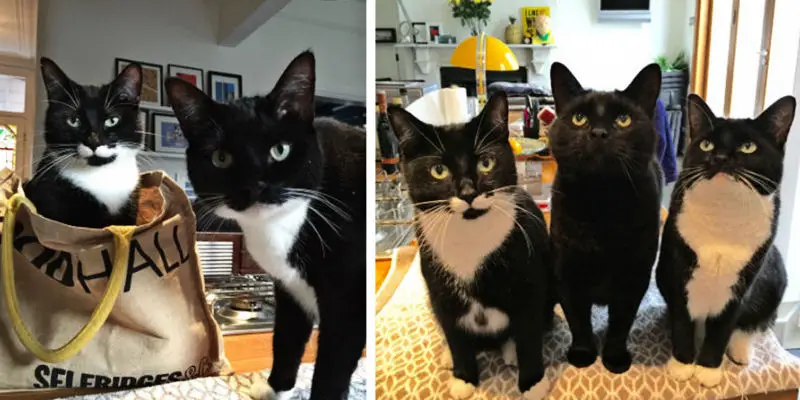
Photo credit: © Marjan Debevere Check out her IG @lillmanlulu_luigi_and_co
OK, we love these guys! Follow their exploits on Instagram and see some really amazing photos!
Zipping across the pond back to America, up next is The Tuxedo Trio from Boston.
Introducing The Tuxedo Trio (aka Boston’s Beauties)
The Tuxedo Trio are a Boston based family consisting of Ben who just turned 5, Jack now 3, and Hugo who is 2. Owner Deb told us that they are the proud owners of three best friends. Ben is the alpha male, always making sure Jack and Hugo know he’s the boss. Jack is by far the most playful. He loves to play fetch and catch–and lately he has been loving it when we blow bubbles around the apartment for him to catch. Hugo is the vocal one, always chirping and talking loudly like he needs attention. She told us she couldn’t imagine her life without them in it. We asked Deb a few questions:
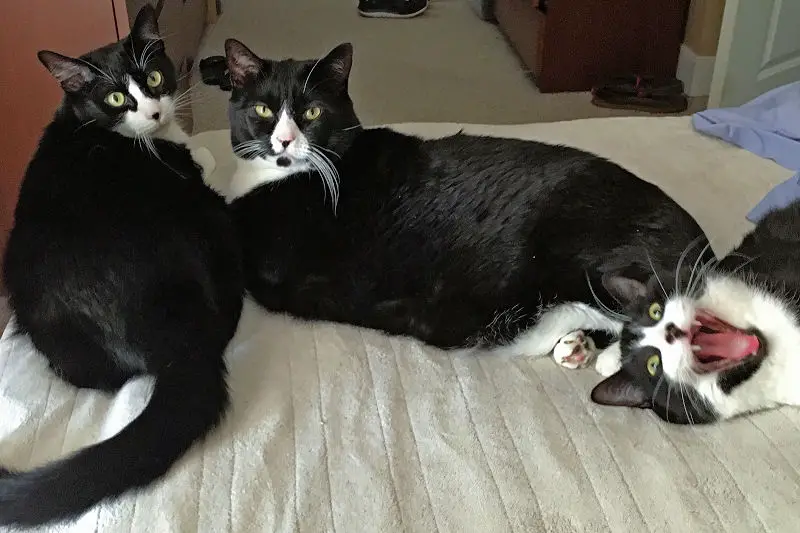
Photo courtesy of @tuxedotrio
Q: Why did you choose tuxies?
It’s weird–they kind of chose me! We wanted to adopt some kittens when we knew our older (orange tabby) cat, Jake, was not going to make it through his bout of bone cancer. Around that time, a friend of the family’s female cat snuck out of the house before her spay appointment and came back pregnant. Not wanting the kittens to end up at a shelter, she began looking for good homes for them all. I told her if she had two boys in the litter, we would take them and it turns out the only two boys in the litter of six were two tuxedos! That’s how we came to adopt Ben and Desmond. Jack came along about a year and a half later–from the same family friend. And then, when Desmond passed suddenly from heart failure, I began looking for another kitten. I wasn’t actively seeking out another tuxedo, but it just so happened that we found Hugo online and I knew I had to adopt him.
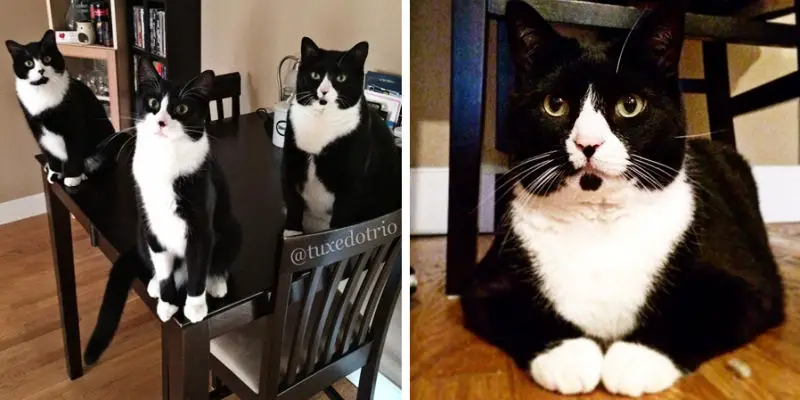
Photo courtesy of @tuxedotrio
[clickToTweet tweet=”A Tribute to Tuxedo Cats” quote=”A Tribute to Tuxedo Cats”]
Q: Funniest moment(s) you’ve experienced with the trio?
I would have to say every day is an adventure with these three guys. Seriously, I can think of so many stories that have made us laugh. One time we came home from work when Ben and Desmond were kittens and found the freezer wide open and all the food from inside it all over the floor. I’m talking melted ice cream, frozen blueberries smashed into the hard wood floor, half-eaten raw chicken ripped to shreds… ugh it was a mess. And that’s how we came to have baby locks on our freezer even though we don’t have any children.
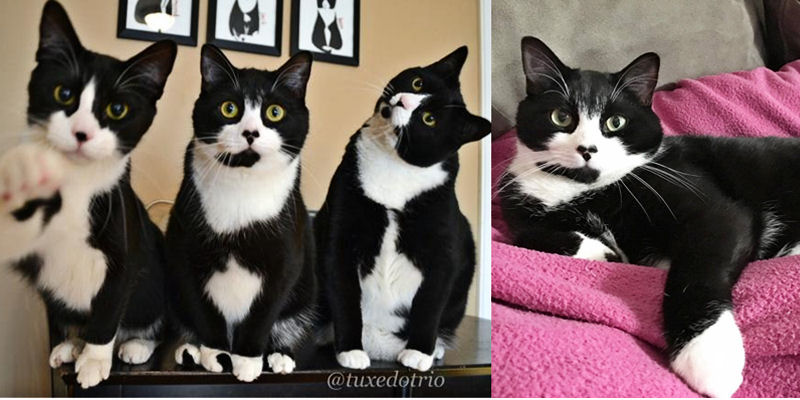
Photo courtesy of @tuxedotrio
Q: Any noteworthy story about their background and/or how you acquired them?
I might as well tell you where their namesakes come from! My husband and I are huge LOST fans, so we named the cats after characters on the show (Benjamin Linus, Jack Shephard, Hugo Reyes, Desmond Hume). That’s also where the design for our shirt designed by YippeeCatYay comes from:
(If you have ever watched LOST, you will get the reference.)
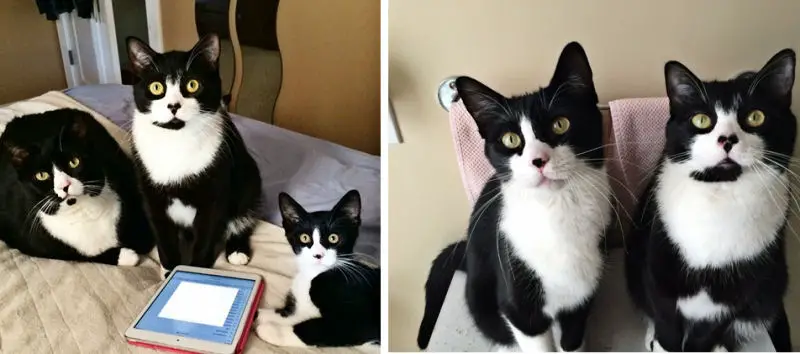
Photo courtesy of @tuxedotrio
One other thing I’d like to add–we have a blog! I like to write posts on city living with 3 cats, arts and crafts, home organization, and product endorsements. I started the blog 5 years ago when I toilet trained Ben and Desmond (Ben still uses the toilet to this day–yes, you read that right) and then just kept writing about the cats and our lives.
We love these guys! Follow their exploits on Instagram here => @tuxedotrio
In closing we wanted to make mention of a very famous tuxedo cat named Simon who in 1949 was awarded the Dickin Medal, which honors animals in wartime. Read his inspirational story…
According to TIME Magazine….Aboard a British Royal Navy ship sailing down China’s Yangtze River, Simon the Cat was a long-time favorite of the sailors on the H.M.S. Amethyst. He was hit by some shrapnel as a result of an attack by Chinese Communist forces. Simon was injured in the leg and back, and his whiskers were singed off. Some of the sailors didn’t think he’d make it through the night.
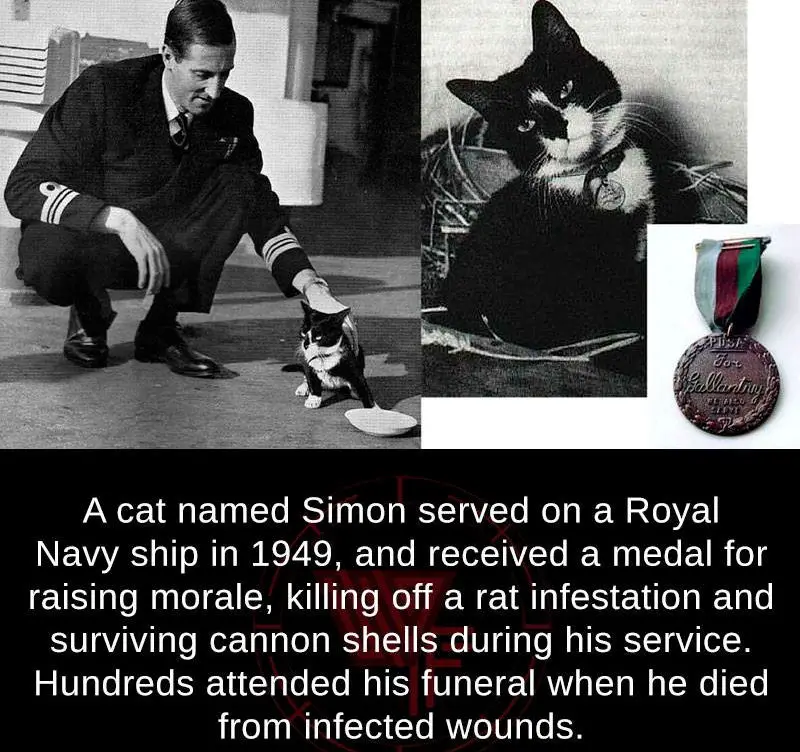
Eventually, Simon recuperated enough to wipe out a massive rodent infestation on board the ship, eventually taking down an enormous rat the sailors named Mao Tse Tung. Later, his exploits became known around the world; he even managed to garner a TIME obituary. In August 1949, Simon was awarded the Dickin Medal, which honors animals in wartime.
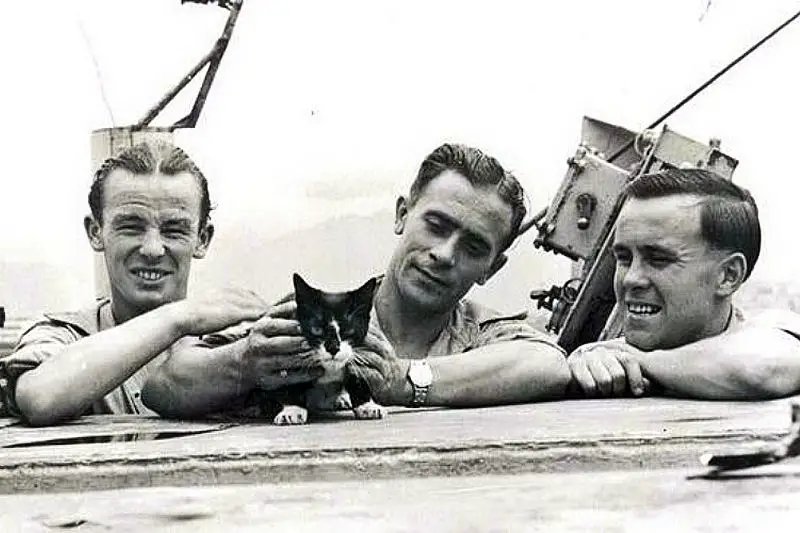
According to Wikipedia, Simon was originally found wandering the dockyards of Hong Kong in March 1948 by Seaman George Hickinbottom, a member of the crew of the British frigate HMS Amethyst stationed there. It was thought that Simon was approximately a year old, and when found, he was very undernourished and unwell. Hickinbottom smuggled the cat aboard ship, and Simon soon ingratiated himself with the crew and officers, particularly because he was adept at catching and killing rats on the lower decks. Simon rapidly gained a reputation for cheekiness, leaving presents of dead rats in sailors’ beds, and sleeping in the captain’s cap. The crew viewed Simon as a lucky mascot.
[clickToTweet tweet=”A Tribute to Tuxedo Cats” quote=”A Tribute to Tuxedo Cats”]
Summary
Are you a fan of tuxies? Drop us a comment below and tell us about your favorite tuxie.
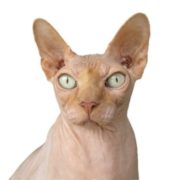

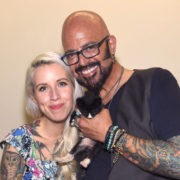
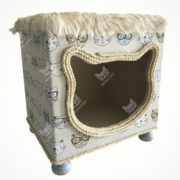
I have had three tuxedo boys, they were the funniest tenacious cats I have ever owned.
Tuxedos are my fav.
I have three tuxedo cats, two boys and a girl…..them them to bits !
Beautiful , fascinating article Richard. I know I’m biased but very interesting all the same
I’ve owned many cats…loved them all but my tuxies were truly special!
My favorite of all cats. I had my tux boy for 19 years. Miss him.
Okay this is making me want another Tux!
Janice, Have you found your Tuxie yet? We have a full house w/ our four boys, 1 Lab, and a bunny.
I’m looking for a home for our pretty, sassy little foster, Miss Sassy-Pants, Monkey-Butt, Twinkle-Toes 😀
She is a little beauty, quite a character, and adjusting surprisingly well, and quickly after some awful, frightening experiences starting with being trapped and taken to a huge, high-kill Humane Society in Tampa, FL.
She was placed on the Euth list there after 2 weeks, pulled by a Tampa “Foster” that turned out to be a hoarder with many aggressive, ill animals, but then rescued from that situation by a great private no-kill rescue.
Through my airline coworker animal rescue/transport network, I obtained her from that private rescue, and transported her to our home for a chance to recover and begin her transition back to her trusting, funny, sweet, social self.
She’s still quite young, a half-grown kitten, and still requires time & patience. But, so rewarding as she’s become more and more comfortable with being handled. Took just a few days till she showed how much she loves to play, a very active girl!
Lots of purrs, loves to be pet, chin scratched, even her tummy (on her terms as yet, usually when first waking or when sleepy). I can share photos if you’d like to consider her. She’s spayed and vaccinated.
I can transport her within the U.S. to her forever home. Let me know. (I know this article and comments are a couple years old). [email protected].
Thanks,
Marsha
360 789-9089
Tuxies always look ready for a wedding. Gorgeous cats.
My first Tuxedo is Tucker (of course! Now not so original!) I helped rescue him from an abusive home at 2 months old. He definitely has personality! My neighbor has a Tuxedo kitten that I kidnap occasionally for play dates with Tucker, and I call him Darth Raider. You’re correct when you say they are friendly. Tucker does not care for strangers, but is affectionate to household members and his kitten buddy.
Mine is named Sylvester and is not friendly to strangers either. Family is fine.
love him to death. He is nine yrs old. Sometimes plays with his “partner in crime ” 7 year old Sheba a yellow tabby.
Thank you for this wonderful article 🙂 Tuxedo cats are really something special. I do not have a Tux but I am the proud owner of a beautiful black and white cow cat.
I have a Tuxedo. Name is Sylvester. He is very large and has an upside down wishbone on this forehead.
BTW he is a rescued cat. Love him to pieces.
The trivia cat is Sebastian, the evil tuxedo cat from “Josie and the Pussycats.”
I have an “almost” Tuxie – his front legs and shoulder have a bit too much white, but his personality fits a Tuxedo exactly. My kitty is an “interior decorator” as he moves the cat beds up and down the stairs or around the house as he pleases.
He loves to play fetch every day and has become quite attached to his favorite toys. He has opened doors on his own. He is demanding for attention, comedic, quite loving, and occasionally a little imp. He tries to outsmart our other two kitties, acting sweet at first but manages to get his way most of the time.
Can a mostly grey cat with white chin, paws, and collar be a tux? My neighbor has a tux named Jeeves.
Mr. Tux is the smartest cat I’ve ever owned. He acts like a dog, is extremely social & curious with guests, and always demands my attention. He has a favorite stuffed animal (a black & white cat!) that he leaves at the front door for me each evening and at the bedside each morning.
Fantastic article. Thank you 🙂
I’ve had two tuxedos. Nightwing and Malfoy. Beautiful cats with lots of personality! I’ll see y’all at the Rainbow Bridge!
I took in stray distressed kittens two years ago. After my Doberman was put down due to old age. I started being proactive in managing and protecting my homeless cat colony on my corner multiplex property. I have a couple of beautiful 1 -2 year old tuxedos and several black and white or bi color cats in this colony. I recently set up misters to keep them cool in the phoenix summer above their preferred outdoor secure area. I would like to post pictures of some and would like to find permanent homes for them. I have four already and spend a lot of time and money supporting these cats that are subjected to the elements of homelessness.
Thank you so much for the very important labor of love you do, @Joe; may you be many times blessed for putting your caring into action!
My Tux (short for Tuxedo Mask) had a bow shaped patch on his chest and a white mask shapped patch on his face. Miss little Tux.
I call mine Dapper because he is. Love him never owned one before but he is the sweetest he chirps to his sister Honey they are litter mates.
You forgot Mooch from the comic strip Mutts! That’s where my tuxedo got her name, and I swear Patrick McDonnell has a camera on her to get ideas for the next thing Mooch does in the comics! My Mooch turned me into a true cat lover!
I have a true tuxedo cat. his name is ZORRO, but also goes by the nickname ( CHIEF ) because at my home, when you come over, you will soon realize, it,s his place, an Im’a tell ya, He runs the show ! That’s how he got the nick name. He is perfect in his color and pattern. He has an unusual black 4 leafed clover placed perfectly on his nose, and a nice round black circle right in the center of his white tummy. looks like his belt buckle. He also has a perfect black got’tee on his chin interrupting the white coloring that runs from his face, down his chest and underside. Oh Yes ! ZORRO is one strikingly hansom little fellow ! The only thing missing with ZORRO, is a Sword ! Ha,Ha,Ha. He is about 8 human years old now and I haven’t had him to the vet recently, but I’m guessing, he weighs in some where between 14 and 16 pounds. We lost his big brother who was a random mixed colored Tux, 2 years ago Nov. His name was James. We called him King James. He was 19 & 1/2 ( human years ) when old age got the best of him. Both of my guy’s have the been the most loyal friends and family I have ever known. So much so, that I cant stand to even think of them as animals. No offence to anyone, but in my life, the animals that I have been around, were the one,s standing on 2 legs and talking, ( Sorry )! I have been looking at the pictures of your beautiful Tux Cats on my lap top, an reading your post’s and I cant help but feel that you just have to get-load of the Chief, I am an older guy that does not know enough about the computer to post a picture, but I will work on that ! ZORRO is sharp ! Both in looks and intelligence. A couple of people now, have told me, he needs to be doing TV commercials. so I figured, at least, he should be on a calendar or something, ( He,s just too cool ). Well, I want to thank you all for your time reading an most of all, for the Love and Care you have and are giving our little TC’s ( Tux Cats ). GOD Bless you all !
Love your post, @Gary, and agree 100% on the “animals” issue — we are all animals, and mammals! but the baser qualities you’re probably thinking of apply absolutely to humans, not members of most other species.
All the best to Zorro and to you!
I have three tuxies with very different personalities. Ranger is a scaredy cat, Rocky is the boss, and Luna is zany and adventurous.
Our Tux cat, Luna, was unforgettable. Intelligent, talkative, extroverted and faster than a locomotive, Luna enjoyed three favorite daily activities – whipping the ball around her Turboscratcher; racing around the house at 2:00AM, then landing on the bed and in my face; and riding our shoulders wherever we were in the house. She reigned supreme in our household of four cats, keeping her amazing pace until the ripe old age of 20.
Excellent tux article!!!
There have been quite a few tuxedos in my life. I currently share Suha’s home with her. Rani is the owner of my heart; she went to the Bridge in 2016. Raj Kumar is, I hope and pray, going strong in Vancouver, Canada. And Tux and Vincent were grey (blue) tuxedo brothers, also gone to the Bridge. All of the cats who have shared my life have always been rescued from the “streets”, shelter, or other situations.
I rescued a tuxedo kitten from a neighborhood car engine (not running!) and brought her home to my two older cats. She was playful and cute. After the two older cats passed away, Ricochet became my close companion. I could see her in the window (2nd floor apartment) when I pulled in the parking lot. She would race to the door to meet me. Playful, affectionate and adorable, loved to fetch pipecleaners and flush the toilet. Unfortunately, she either ate a spider or was bitten by one even though she was an indoor cat. She died at age 6. I cried for weeks and still miss her. I didn’t want to get another cat, but my sis convinced me to adopt a rescue kitty named Harper Lee. She’s not a tuxie but is a playful, friendly, crazy cat with an almost iridescent silver coat.
We have a Tuxie called ‘Cobweb’ that we found as a tiny kitten wandering around our property and crying his head off. He’s going on 3 now and rules our house and our dog ‘Hester’, lol!
One of my three tuxedos has a tiny bit of white on his chin, chest, belly, and tip of his tail, but none on his feet. Does that mean he’s not a tuxedo? That checklist seemed to say that the white needs to be on the feet as well.
We just lost our Tuxie named Zulu. He lived for 9 years and he was very much as this article described. A very outgoing, loveable cat that followed me around. RIP Zulu.
My tuxedo cat is (surprisingly) named “Tux”. My other cat is a gray and white longhair, and I guess you could call his pattern tuxedo but he’s gray, not black. Anyway, his name is Newman! Funny! They are both 9 years old. Not related. Keep up the good work!
Cat in my profile pic is my 3rd cat, Cali. She is either a calico or a tortie, I can’t really determine which. She is ALSO 9 years old. None of the three cats are related to each other, but they are the same age.
So true! I never knew the characteristics were tuxedo cat specific, but mine is smart, vocal, and VERY friendly. It takes everyone that meets him aback, since most aren’t used to cats being so social. He prefers being carried around on my hip like a baby or curled around my shoulders to walking, and will sprawl out on anyone’s lap that will pet him.
Our Prof Higgins is a classic Tux Feller 🙂 A beauty, regal, and zany, loving, and so silly! He has a perfect heart marking on his chest. I found him as a stray, being lured with food, then teased, and shouted at by ill-behaved kids (as their idiot parents looked on) at a Food Fest, in a Camas, WA park. He followed me, batted at my ankles.
I picked him right up, from under the brat’s noses, and brought him home.
Turns out, (per info recovered via chip & assoc shelter), he and his sister had been adopted by a kind, well-known, elderly widower, local CPA, whose home was near the park & library.
The gentleman had gone into hospice with a promise from his young-adult granddaughter & boyfriend that they would care for his kitties (2) while living in his home, or return them to the orig shelter, West Columbia Gorge Humane Society.
They put the kitties out, did not contact the shelter & did nothing to care for them.
The 2nd kitty, Kerry was found as a very thin stray approx 6 mos later & found a new home after going back to the orig shelter.
Higgins is an exceptionally smart, personable & loving guy. We’re so lucky to have him. I hope somehow, Mr. David S. knows his loved, little kitties are ok.
P.S. For any & all of you Tuxie-fans reading…we have a beautiful, sassy, funny, loving little foster kitten who needs her forever home.
Miss Sassy-Pants, Monkey-Butt, Twinkle-Toes. Very pretty, bright white whiskers, white cravat, pretty white/grey markings on tummy, 4 white mitts, and charcoal-grey toe beans 🙂
She was shuffled from a huge, awful high-kill shelter, placed on their euth list, pulled by a “foster” who turned out to be a hoarder with many aggressive, ill animals, but then rescued from that mess by a private no-kill rescue, and placed with us to regroup, and for socializing.
She is still young, a half-grown kitten. Requires patience, but is making great progress daily. 2 weeks in…very funny, loves to play now, lots of purrs, and pettings (even her tummy) on her terms.
If interested, contact me at [email protected]. I can transport her to her new forever home within the U.S.
I’m ready now for a Tuxie cat maybe 2. I had a Turkish Van for 17 years and he crossed the rainbow bridge 4 years ago. I would like to find rescue but kittens if possible. Thanks to all for sharing their stories. MEOW!!
If anyone wants a TUXEDO CAT – they have MANY of them at a No-kill shelter in Columbus, Ohio named Colony Cats.
I just got my first Tuxedo cat there and he is wonderful – but they have many more…
Please call them at (614) 570-0471
or go to their website to see what they have available.
https://www.colonycats.org/
They have so many and they all need homes.
My poor guy was there for two years before I walked in and fell in love with him.
I have an unusual, gorgeous tux with a white face, rolled up sleeves, and a bad haircut. His formerly stray mother is a real tux, and his father is probably a black house panther. American tuxes are fantastic, smart cats. Now I know why!
I have a cat and have a white and black tuxedo cat his name is Bruno he looks like the picture with all three cats you have on your website I like your cats are cute too
I have one Tuxy Othello and hes my sweetheart and I adore him. He’s very playful and polite.
He walks on a leash but if its a long walk he rides in a wearable pet satchel. Othello also saved my life. I was feeling pretty bad thought I was sick. Went to lay down to sleep. Didnt know how long I slept but was wakened by Othello jumping on me full force with all four paws. Normally this would wake me up instantly. But not that time,he did this
Repeatedly and I came to realize something serious was happening. I felt stupified,and could not think straight and I was very clumsy. Eventually with Othello jumping on me like that and sniffing my breath I fumbled with my phone and called 911.I was so out of it. Anyway I was admitted to the hospital and it was alla blur untill I finally came around to discover I had just been diagnosed with diabeties. Othello was sniffing my breath because when blood sugar levels get too high the breath is fruity,too low it is like nail polish remover because of the ketones in the blood. Othello not only saved my life,he already diagnosed my problem. He watches over me and will make me stop what I’m doing so he can sniff my breath. When he does this I check my blood sugar levels and sure enough they are significantly up or down,not dangerously so but enough I have to remedy the situation. Othello is my heart and my hero.
Current little buddy is the 7th Tux since ’84. Bubba, Boo Boo Kitty, Bullwinkle, Bonehead, Beavis, Boots and now, Buster. Yes, all have had “B” names, but it’s a coincidence. I didn’t name every one of them. All have been personable, and a joy to know. It’s nice to know that so many others see the nature of these kitties the same way as I. Bubba caused me to violate a no pets lease, and yes, I lied about him when queried! He’d likely not have made it without me. Had to teach him to bathe himself. Since then, my little friends have brought a pleasure to life that’s hard to describe. Buster is turning a year and is Tux to the bone. God has truly blessed us all!
I so love tuxedos. The very first tux I had was named trouble maker, trouble or troubs for short. I said jokingly one day that you are nothing but a little trouble maker…and there you go. He was the best cat and certainly the best tux ever. We would play all kinds of games together, but none more fun than tag. Yes, tag, lol. If I started then I’d gently tap him on the head and take off running, and Trouble would of course give chase. When he caught me he would wrap his front paws around my ankles then if he still wanted to play he would take back off running. It was funny watching him try and get traction on the linoleum floor. Now if he wanted to start tag, he would casually walk up like I ain’t doing anything and then smack. I’d feel him slap my ankle with his paw and he’d take off running. Sometimes he would run just a bit then stop and look at me like do your best to catch me. I’d talk to him alot…..ohhh I know what you want….and I’d start chasing him around the house. I’ve never had a cat like him since, but it was just us for a long time. My husband worked nights then, and we didn’t have kids yet. I knew just what he thought and wanted all the time, and I think he did me too. He died young. Troubs was just 3 1/2 years old. I have my suspensions how and who, but nothing I could ever prove. My first son was born 2 weeks later. I don’t think he would have hurt ryan, but I’m a believer in things happening for a reason. We were real tight that cat and I. Oh how I miss him. The tux I have now is named TJ for Trouble Junior, no relation to Trouble though. My TJ is about 16 years old, and that’s the longest I have ever had a cat. He has a T in his fur pattern on back leg. TJ is my momma’s boy, lol. Lastly, this is something I thought of, I’m sure I’m not the only one ,but let’s make it virul…….#lovethetux
Maggie May from The Purring Journal is a tuxie! We love her to pieces.
I just lost my incredible tuxedo cat, Smudge, this past August. She was 19 years old (I think). I adopted her by happenstance when I went to adopt a kitten. Smudge, the mama cat, jumped up on a table and began trolling for pets. I was enchanted and asked if I could have her instead. It was love at first sight. Personality plus, affectionate as hell, playful and funny. I still cry every time I look at her picture. Tuxies are the best.
I lost my beautiful tuxedo cat, Lola, the day after Thanksgiving. She was only 12. She had developed an oral cancer which was very aggressive. She went downhill so quickly and I just wasn’t ready to say goodbye, but I had to end her suffering, so we made that sad last trip to the veterinarian’s office. I have cried every day since.
Lola was very much as people have described in these comments. She was super smart and very vocal. She followed me around the house 24/7. And she was bossy! She also had a daily routine and made sure I followed it to her liking. We went to bed when Lola said it was time to go to bed.
Lola was my second tuxedo. She was preceded by Natasha. I had Natasha for 16 years. Their personalities were very similar. Neither was actually a lap cat, but they were always close by.
I miss my tuxedo kitties. After my heart mends, I will be looking for my next tuxedo friend.
My tuxedo Tom-Cat and his 1/2 Siamese 1/2 Tux sister Nefertiti are the best cats I’ve ever owned. They have the same exact white paw ratio & body coloring. He’s just a true tux & she is Siamese on the top.
I absolutely loved this tribute to tuxies! Their charming personalities and unique markings always bring so much joy. It’s wonderful to see them celebrated in such a heartfelt way. Thank you for highlighting their ‘tuxitude’! 🐾
I absolutely loved this tribute to Tuxies! Their unique personalities and charming ‘tuxitude’ truly shine through in your writing. It’s wonderful to celebrate our feline friends who wear their black and white coats with such style. Thank you for sharing these heartwarming stories!